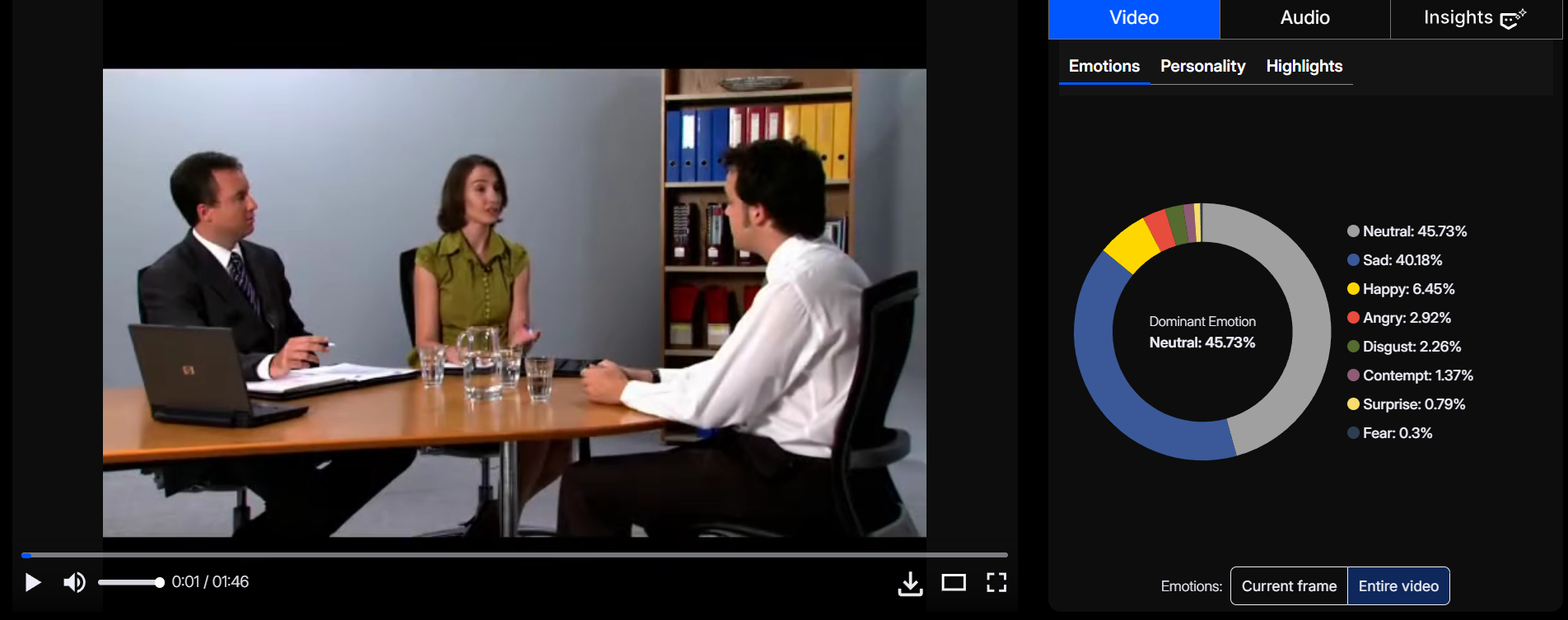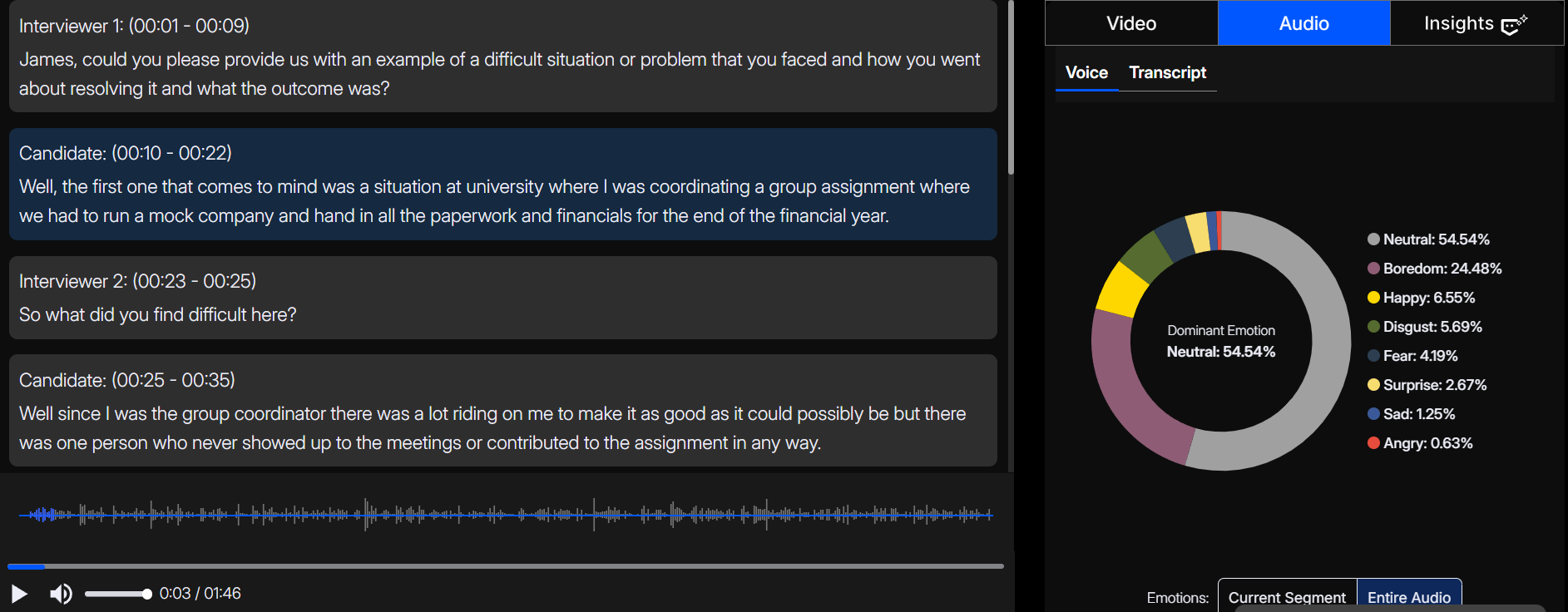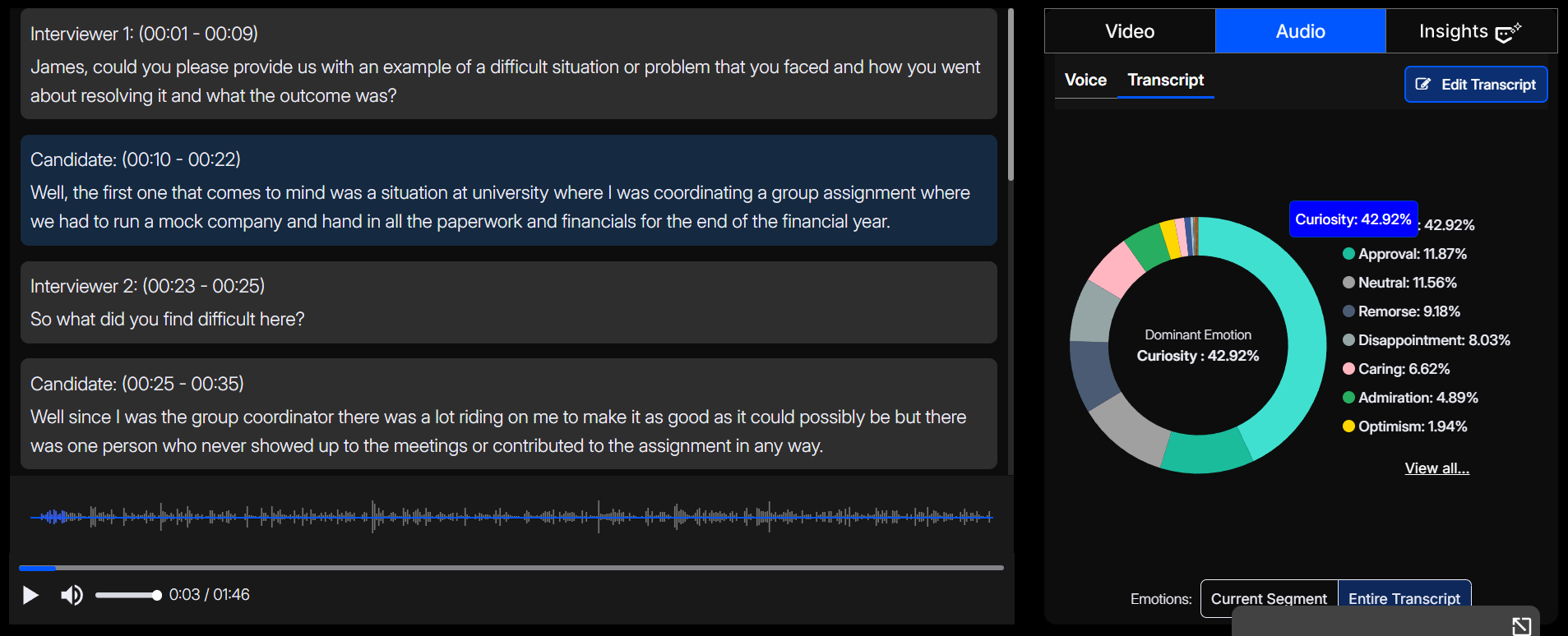.jpg?alt=media&token=c1c5278b-7308-495c-9dac-f814515a6957?w=3840&q=75)
Bringing Emotional Clarity to Panel Interviews with Emotion AI
Panel interviews give hiring managers a fuller picture of candidates by showing how they respond in real time, under pressure, and in front of multiple decision-makers. Yet these sessions often create challenges. One candidate takes charge of the conversation, while another struggles to get a word in. Interviewers often mistake quietness for a lack of confidence, and nerves can hide genuine potential. With several people in the room, subtle cues go unnoticed. Interviewers themselves form quick opinions, which research shows form within 7 seconds. All these can lead to biased or rushed conclusions.
This is where Imentiv AI helps. Using multimodal emotion recognition, that is, by analyzing video, audio, and text together, it captures what interviewers often miss in the moment. You can see who listens, who collaborates, when stress appears, and when confidence shines through. Instead of relying on quick impressions or gut feel, HR teams get measurable insights into each candidate’s behavior. This may make the panel interview outcomes better and more reliable.
Why Emotion Matters in Hiring?
Hiring isn’t just about what candidates know. It’s about how they connect, adapt, and work with others. Emotional intelligence, resilience, and listening skills often decide whether someone will thrive in a team or leadership role. But these qualities usually show up in subtle signals: a calm voice under pressure, a pause to think before answering, or a moment of empathy. Without the right tools, those signals may go unnoticed.
Research shows that when companies move beyond first impressions and use structured, behavior-based insights, interview accuracy improves by 20-30 percentage points. Imentiv AI makes this possible by turning signs of stress, empathy, or adaptability into measurable data. That means emotion AI in recruitment can help HR make decisions based on clear evidence, not just intuition.
How Imentiv AI Works in Panel Interviews
Imentiv AI applies its multimodal emotion analysis to decode behavior in multi-speaker environments.
1. Video Analysis
Detects facial expressions, micro-emotions, and body language across multiple participants simultaneously.
Identifies who looks disengaged or who expresses stress during peer responses.
2. Audio Analysis
Separates overlapping voices with speaker diarization, mapping exactly when each candidate speaks.
Measures vocal tone, pitch, hesitation, and emotional cues to show confidence, nervousness, or frustration.
3. Text/Transcript Analysis
Transcribes and evaluates word choice, sentiment, and emotional granularity.
Highlights patterns: Are responses thoughtful and empathetic? Are they rushed or defensive?
Analyzing a Mock Panel Interview with Imentiv AI
To illustrate the impact, let’s look at an example. A short mock panel interview video (1 minute 46 seconds) from YouTube was analyzed through Imentiv AI’s platform. The Emotion AI broke the analysis into video, audio, and transcript layers, each offering unique insights into both the candidate and the interviewers.
Video Analysis


When the video is analyzed, the candidate and both interviewers together show mostly neutral emotions at 45.73%, with an unusually high level of sadness at 40.18%.
The candidate in particular shows sadness at 56.7%, far higher than any positive emotions. His low positive valence score (-0.116) suggests stress, nervousness, or a lack of confidence. For recruiters, this may indicate a candidate who is either underprepared, overwhelmed by the panel format, or struggling with self-expression under pressure.
Among the interviewers, Interviewer 1 appears mostly neutral (65.7%) but with signs of sadness (25.5%). This is possibly signaling fatigue, skepticism, or even empathy toward the candidate. Interviewer 2 shows a more mixed profile, combining neutrality (57.3%), anger (10.4%), and some happiness (9.8%). This fluctuation could point to inconsistent engagement, moments of frustration alternating with positive reinforcement.
What it means: Video cues highlight that emotions such as stress or disengagement often drive judgments, even when they go unnoticed.
Audio Analysis

Voice-based signals reveal another layer of the story. Across the panel, participants expressed mostly neutral tones (54.54%), but boredom appeared at 24.5%.
Interviewer 1 remained largely neutral (82.7%), which might reflect composure or detachment. The candidate leaned toward boredom (44.6%) and neutral (43.13%), possibly indicating disinterest or regret about how the interaction was unfolding. Interviewer 2, on the other hand, conveyed more engagement, balancing curiosity and care in their tone.
What it means: Vocal tones often reveal what faces don’t, that is, boredom, stress, or disengagement.
Transcript Analysis

The transcript reveals the cognitive and conversational dynamics. Curiosity appeared most often (42.9%) , suggesting that interviewers were genuinely probing for more information. Approval (11.8%) and remorse (9.1%) also appeared, showing a mix of encouragement and subtle disappointment in responses.
Interviewer 1’s transcript revealed intense curiosity (99.1%) , despite their neutral vocal delivery. This highlights the gap between spoken tone and actual intent. The candidate’s text showed a mix of approval (23.7%) , neutral (22.7%) , remorse (18.3%) , and disappointment (16.1%) , reflecting boredom, stress, and moments of engagement. While interviewer 2 showed curiosity (65.9%) and caring (32.1%) , contributing empathy to the group dynamic.
What it means: Text analysis highlights intent and mindset, not just mood. Even when vocal or visual cues suggest detachment, the conversation itself may be driven by curiosity and constructive evaluation.
Combined Insight
By layering video, audio, and text, Imentiv revealed both the candidate’s internal state and the interviewers’ influence on the session. The candidate showed visible stress, the panel reflected mixed levels of engagement, and curiosity ultimately drove much of the dialogue.
Interestingly, the three modes of analysis told slightly different stories. The transcript revealed strong curiosity, with interviewers asking probing and information-seeking questions. Yet, the video and audio data showed mostly neutral expressions and flat vocal tones, sometimes even bordering on boredom. At first, this may seem contradictory.
What this shows is that people express emotions differently through words, tone, and expressions. In a formal interview, the interviewer’s curiosity can appear in language without showing on the face or in the voice. To maintain professionalism, interviewers often keep a controlled demeanor, holding expressions and tone neutral. The text analysis captured their intent, while the video and audio reflected restraint.
For recruiters, this layered insight is powerful. It demonstrates that candidates and interviewers can express one emotion verbally while masking it nonverbally. Imentiv makes these patterns visible, turning potential blind spots into measurable data. By surfacing signals like stress, disengagement, or empathy across all three layers, it ensures that hiring decisions are based on a fuller, more reliable picture rather than surface impressions.
Better Assessments, Stronger Teams
One of the key benefits of using Emotion AI in panel interviews is that it can bring more balance and clarity to the process. Without it, panel decisions risk being swayed by -
- Bias toward extroverted candidates.
- Overvaluing polished, rehearsed answers.
- Misjudging silence or hesitation as weakness.
- Snap judgments are made in the first 7 seconds.
With Imentiv AI, HR teams can potentially gain:
- Holistic profiles of each candidate’s emotional and collaborative style.
- Reduced bias, as data highlights emotional patterns beyond subjective impressions.
- This creates better outcomes and ensures that diverse communication styles are recognized and valued.
Building a Better Recruitment Future
At Imentiv AI, we believe technology should amplify, not replace, human judgment. We help interviewers take better, more empathetic, and more human-centered hiring decisions by combining the precision of multimodal analysis.
Panel interviews no longer have to be exercises in stress or bias. With Emotion AI, they become opportunities to see candidates as they truly are: not just as individuals, but as future teammates.